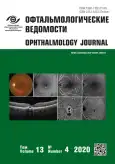Anti-vegf therapy in treatment of vitreous hemorrhage due to proliferative diabetic retinopathy
- Authors: Galimova A.B.1, Galimova V.U.2
-
Affiliations:
- Russian Centre for Eye and Plastic Surgery
- Bashkir State Medical University
- Issue: Vol 13, No 4 (2020)
- Pages: 83-88
- Section: In ophthalmology practitioners
- URL: https://journals.rcsi.science/ov/article/view/42466
- DOI: https://doi.org/10.17816/OV42466
- ID: 42466
Cite item
Abstract
Purpose. To investigate the possibility of anti-VEGF therapy use in treatment of vitreous hemorrhage due to proliferative diabetic retinopathy without signs of vitreoretinal traction.
Materials and methods. In this case series study, 8 patients with severe vitreous hemorrhage due to proliferative diabetic retinopathy without signs of vitreoretinal traction were treated with intravitreal ranibizumab injections using treat-and-extend regimen. Patients were followed for 12–54 months.
Results. . Intravitreal ranibizumab injections using treat-and-extend regimen promoted a complete resolution of vitreous hemorrhage in one month after the 2nd or the 3rd monthly ranibizumab injection, followed by a significant visual acuity improvement.
Conclusion. Anti-VEGF therapy using treat-and-extend regimen could be recommended for treatment of vitreous hemorrhage due to proliferative diabetic retinopathy without signs of vitreoretinal traction.
Keywords
Full Text
##article.viewOnOriginalSite##About the authors
Aysylu B. Galimova
Russian Centre for Eye and Plastic Surgery
Author for correspondence.
Email: aible@mail.ru
ORCID iD: 0000-0001-7311-0954
SPIN-code: 2098-1918
MD, PhD, Cand. Sci. (Med.), Head of Ophthalmology Department, Russian Centre for Eye and Plastic Surgery of the Ministry of Healthcare of the Russian Federation
Russian Federation, UfaVenera U. Galimova
Bashkir State Medical University
Email: galimova.v@mail.ru
ORCID iD: 0000-0002-1610-108X
MD, PhD, Dr. Sci. (Med.), Professor, Chair Professor of Department of Opthalmology with PEI Course. Bashkir State Medical University of the Ministry of Healthcare of the Russian Federation
Russian Federation, UfaReferences
- IInternational Diabetes Federation. IDF Diabetes Atlas, 9th edn. Brussels, Belgium: 2019. Available at: https://www.diabetesatlas.org. Accessed: 2020 Aug 14.
- Yau JW, Rogers SL, Kawasaki R, Lamoureux E, et al. Global prevalence and major risk factors of diabetic retinopathy. Diabetes Care. 2012;35(3):556-564. https://doi.org/10.2337/dc11-1909
- Muller A, Lamoureux E, Bullen K, Keeffe JE. Factors associated with regular eye examinations in people with diabetes: results from the Victorian population health survey. Optometry and Vision Science. 2006;83(2):96-101. https://doi.org/10.1097/01.opx.0000200678.77515.2e
- Kolias AN, Ulbig MW. Diabetic retinopathy: Early diagnosis and effective treatment. Dtsch Arztebl Int. 2010;107(5):75-84. https://doi.org/10.3238/arztebl.2010.0075.
- Шадричев Ф.Е., Астахов Ю.С., Григорьева Н.Н. и др. Эпидемиологические аспекты поражения сетчатки при сахарном диабете (результаты скрининга диабетической ретинопатии в Санкт-Петербурге). Офтальмологические ведомости. – 2009. – Т. 2. – № 4. – С. 13–18. [Shadrichev FE, Astakhov YuS, Grigor’eva NN. et al. Epidemiologic aspects of retinal damage in diabetes mellitus (diabetic retinopathy screening results in Saint Petersburg). Ophthalmology Journal. 2009;2(4):13-18.(In Russ.)]
- Eshaq RS, Aldalati AM, Alexander JS, Harris NR. Diabetic retinopathy: Breaking the barrier. Pathophysiology. 2017;24(4):229-241. https://doi.org/10.1016/j.pathophys.2017.07.001.
- Cuevas P, Outerino L, Azanza C, et al. Dramatic resolution of vitreous haemorrhage after an intravitreal injection of dobesilate. Military Medical Research. 2015;2:23. https://doi.org/10.1186/s40779-015-0050-5.
- Gross J, Glassman A, Jampol L. Panretinal photocoagulation vs. intravitreous ranibizumab in proliferative diabetic retinopathy: a randomized clinical trial. JAMA. 2015;314(20):2137-46. https://doi.org/10.1001/jama.2015.15217.
- Gupta V, Arevalo JF. Surgical management of diabetic retinopathy. Middle East Afr J of Ophthalmol. 2013;20(4):283-92. https://doi.org/10.4103/0974-9233.120003.
- Early vitrectomy for severe vitreous haemorrhage in diabetic retinopathy. Two-year results of a randomized trial. Diabetic retinopathy study report 2. The Diabetic Retinopathy Vitrectomy Study Research Group. Arch. Ophthalmol. 1985;103(11):1644-52.
- Le Mer Y. Indication for vitrectomy in the first haemorrhage. Proceeding of the 19th Euretina Congress. 2019 Sept 5-8, Paris, France. https://euretina.conference2web.com/
- Инструкция по медицинскому применению лекарственного препарата Луцентис® (изменение от 15.06.2020), регистрационное удостоверение ЛСР-004567/08 от 16.06.2008, переоформлен 16.09.2019. [Instruktsiia po meditsinskomu primeneniiu lekarstvennogo preparata Lucentis® (izmenenie ot 15.06.2020), registratsionnoe udostoverenie LSR-004567/08 ot 16.06.2008, pereoformlen 16.09.2019. (In Russ.)]
- Gross IG, Glassman AR. A novel treatment for proliferative diabetic retinopathy: anti-vascular endothelial growth therapy. JAMA Ophthalmol. 2016;134(1):13-14. https://doi.org/10.1001/jamaophthalmol.2015.5079.
- Spaide RF, Fisher YL. Intravitreal bevacizumab (Avastin) treatment of proliferative diabetic retinopathy complicated by vitreous hemorrhage. Retina. 2006;26(3):275-278. https://doi.org/10.1097/00006982-200603000-00004.
- Espinosa AA, Mendoza GB, Toro Millan MA, et al. Intravitreal bevacizumab in vitreous haemorrhage secondary to PDR. Retina today. 2012;4:36-38.
- Palarie N, Pasenco T, Lorina V. Intravitreal bevacizumab for vitreous hemorrhage in proliferative diabetic retinopathy: 3 year results. Proceeding of the 19th Euretina Congress. 2019 Sept 5-8, Paris, France. https://euretina.conference2web.com
Supplementary files








